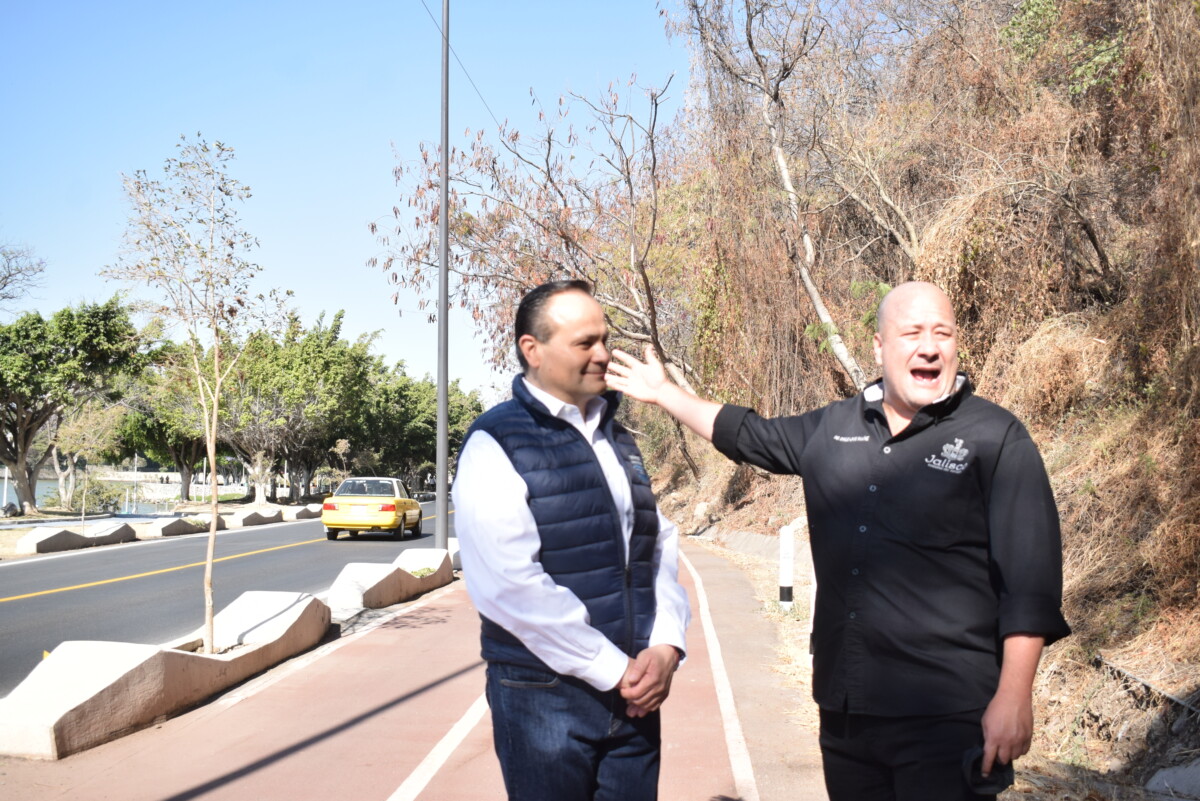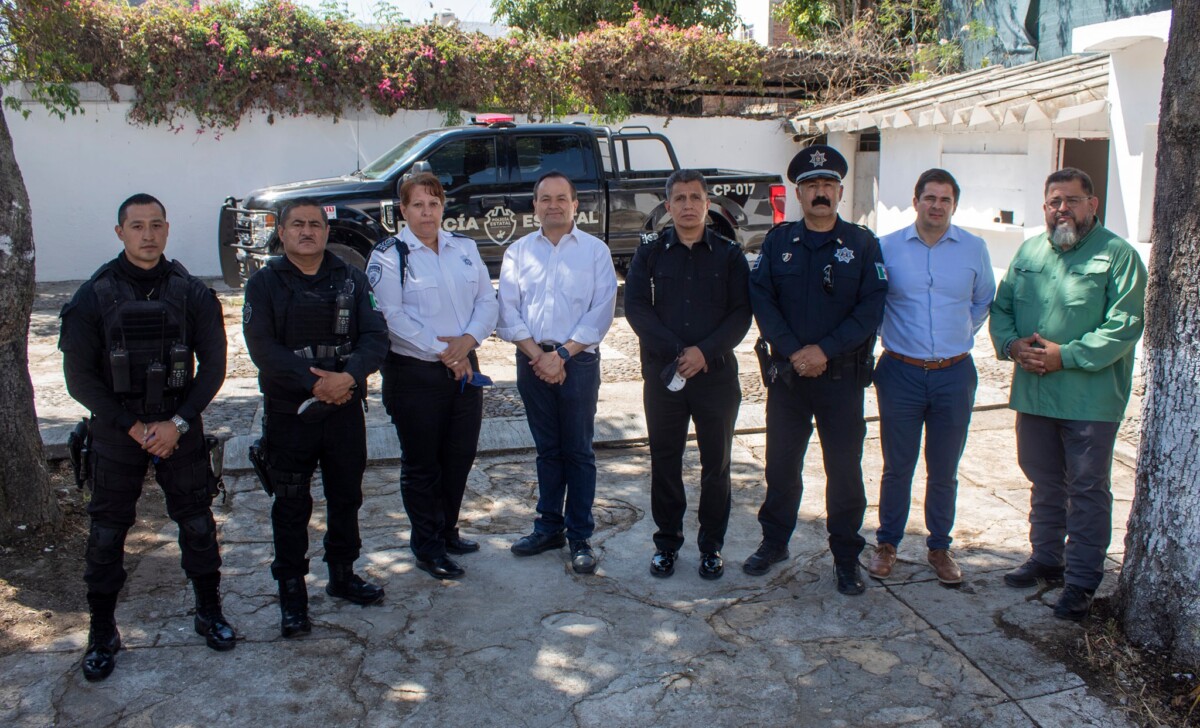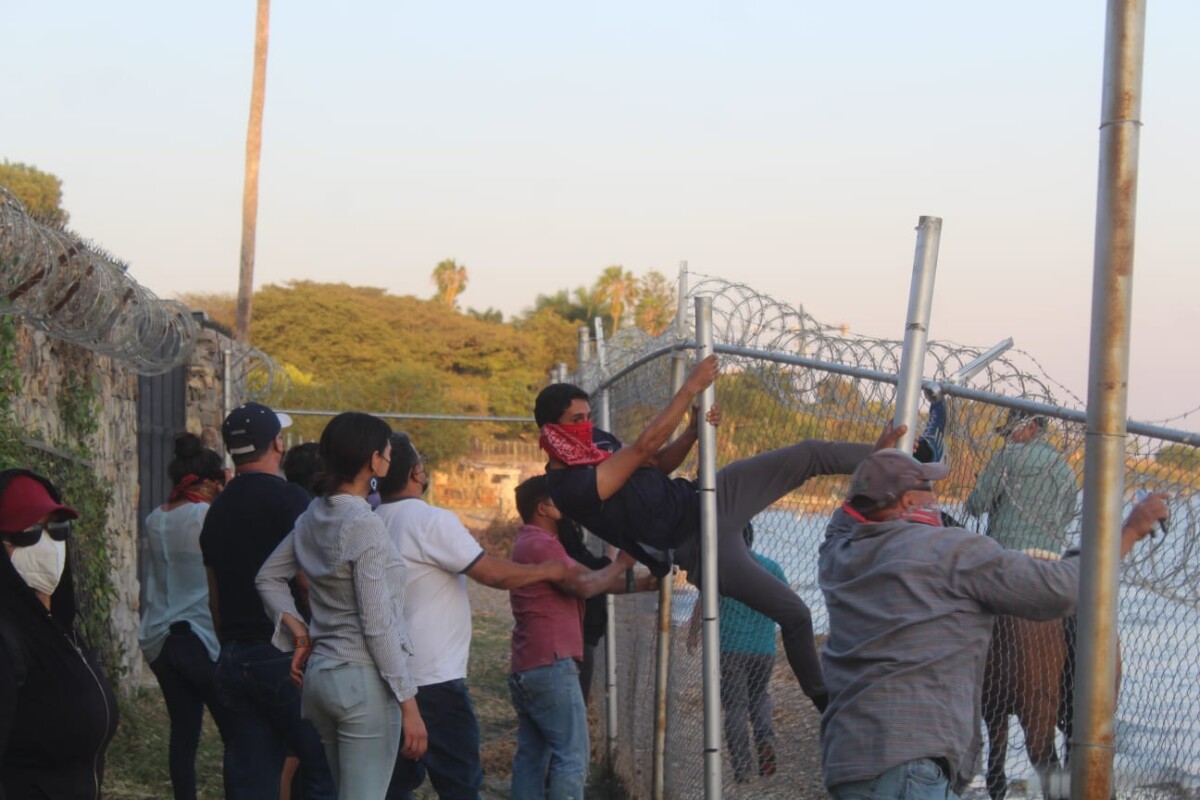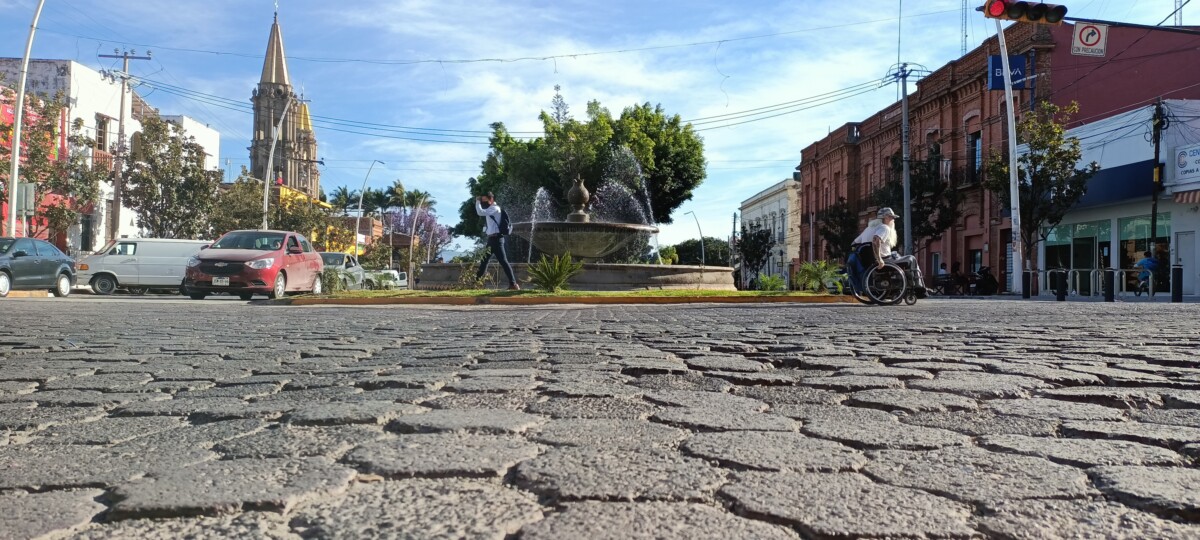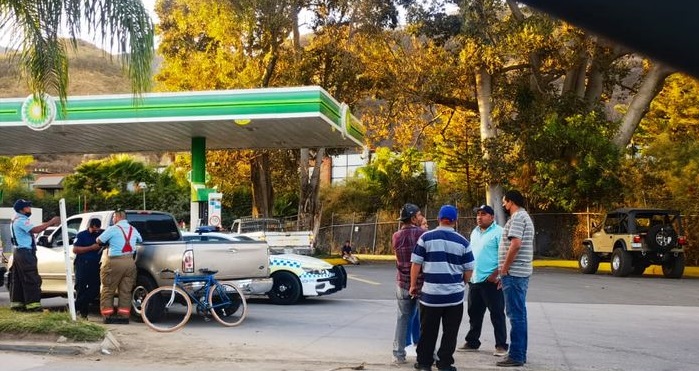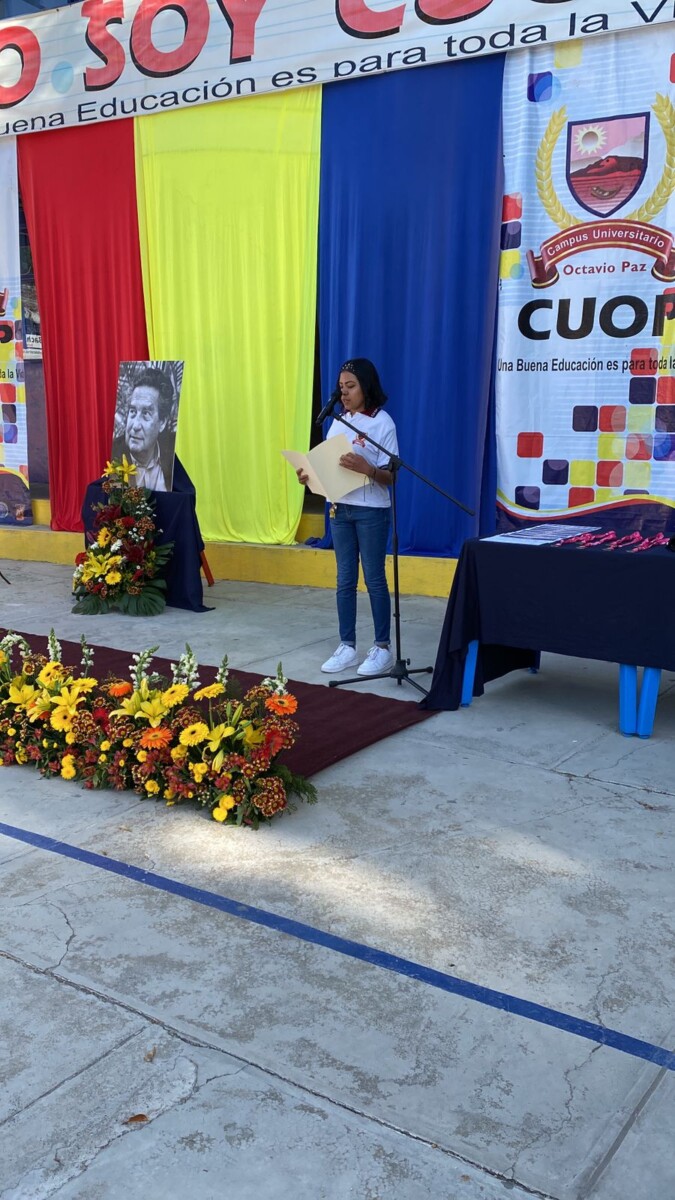Chapala
Governor of Jalisco announces investment of 213 million pesos for four projects in Chapala
Jalisco Governor Enrique Alfaro Ramírez together with Chapala President Alejandro de Jesús Aguirre Curiel during the dedication of the 16 kilometers of bicycle lanes in Chapala, in front of La Milagrosa park, at the entrance to the municipal capital. Photo: Jazmín Stengel.
Jazmín Stengel(Chapala).- Jalisco governor Enrique Alfaro Ramírez announced an investment of more than 213 million pesos for four projects during his working tour of Chapala on March 25, 2022. He also inaugurated the Chapala – Jocotepec bike path, toured the 63.32 million pesos rehabilitation of the Auditorio de la Ribera and promised funds for the rehabilitation of the Santa Cruz de la Soledad highway to Ixtlahuacán de los Membrillos.
During his tour he announced the upgrades to Francisco I. Madero Avenue in the municipal capital and, and the Telesecundaria ‘Guadalupe Victoria’ school in Santa Cruz de la Soledad, and more facilities for the Instituto Tecnológico Superior Mario Molina’ campus.
The Instituto Tecnológico Superior will receive 40 million pesos to build 18 new, fully equipped classrooms, multi-purpose rooms and a library. In addition, Governor Alfaro promised to have the Jalisco High Speed Internet Network ready in the next three weeks. This network will also be implemented at the ‘Guadalupe Victoria’ high school.
During his visit to the Telesecundaria in Santa Cruz de la Soledad, the governor said he had spent $12.9 million pesos on the new infrastructure and promised those present to be able to inaugurate the new classroom modules.
Governor Alfaro Ramírez inaugurated the 16 kilometers of bicycle lanes that were built in the municipality of Chapala as part of the state program MiBici. The work that began in 2019, was carried out in two stages with a complementary project that had a cost of 87 million pesos.
The bikeway, which starts in the municipal capital of Chapala and ends at the junction of the Jocotepec beltway along 24.3 kilometers, had a total cost of 211 million pesos, said Enrique Alfaro.
The Governor also announced an upgrade to the entrance to Chapala at Francisco I. Madero Avenue, a 900 meter-long project designed in multiple stages to avoid affecting traffic at Chapala’s busiest intersection. He showed a video detailing how the project would look.
The project has three main objectives. The first is to improve the roadway, replacing the current cobblestones with hydraulic cement and renovating the water and sewage networks that run underneath it. The second is to arrange the parking lot in parallel so that cars «no longer back up» along the avenue, thus avoiding traffic mishaps and maintaining two traffic lanes.
Finally, the project will improve the image of the city’s entrance by installing a fountain on the walkway, almost in front of the San Francisco de Asís parish. It will also extend the bicycle path to the boardwalk, turning the avenue into a «shared street», and modernize the existing outdoor furniture and add new trees.
The 17.5 million-peso cost for the first stage has been secured and the work will begin after the Holy Week-Easter vacations. Although no budget for the total work was disclosed, Chapala Mayor Aguirre Curiel estimated a total cost of approximately 80 million pesos.
A percentage of the still unconfirmed budget will be given to the avenue’s merchants so that they can also improve their image by making it more uniform. This work has been delegated to the Chapala City Council to begin the organization and work with merchants. The construction will be managed by the Secretariat of Infrastructure and Public Works of the State (SIOP).
Translated by Patrick O’Heffernan
Entrega Ayuntamiento de Chapala instalaciones para cuartel de la Policía del Estado
Autoridades municipales y del estado durante la entrega del inmueble que se ubica en la esquina de la calle Niños Héroes y Zaragoza. Foto: Ayuntamiento de Chapala.
Redacción.- El Ayuntamiento de Chapala pagará la renta del inmueble que ocuparán los elementos de la Policía Regional de Jalisco y la Dirección de Movilidad, gracias a la firma de un convenio de comodato entre las autoridades municipales y el estado.
El acuerdo establecido el pasado 25 de marzo entre el alcalde de Chapala, Alejandro de Jesús Aguirre Curiel, y el comisario de la Policía Regional, Abraham Isaac Chávez Velázquez, permitirá el cambio de los elementos estatales de las instalaciones que ocuparon por algunos años en un pequeño edificio ubicado en el Parque de La Cristianía.

Firma del convenio de comodato entre las autoridades municipales y de Jalisco para la entrega del inmueble de la antigua Comisaría de Chapala. Foto: Ayuntamiento de Chapala.
La mudanza supone un espacio digno para que los elementos de la Policía Estatal continúen con los trabajos en coordinación con la Comisaría Municipal y así garantizar la seguridad de la población a días de iniciar el periodo vacacional de Semana Santa y Pascua.
Por su parte, el secretario de Seguridad Pública del Estado de Jalisco, Juan Bosco Pacheco Medrano, a quien se le hizo entrega de las nuevas instalaciones a ocupar, informó que el inmueble es una herramienta que dignifica el trabajo policial a la vez que continuará con la coordinación con el municipio para dar tranquilidad tanto a los habitantes como a los turistas.
“Me es grato informarles que hemos entregado instalaciones dignas en comodato para que los elementos de la Secretaría de Seguridad Estatal tengan su base de operaciones”, compartió el alcalde a través de redes sociales y reiteró: “la seguridad y tranquilidad de las familias de Chapala y sus visitantes es prioridad para este gobierno”, refiriéndose a la administración que dirige.

El Ayuntamiento de Chapala paga la renta del inmueble desde el año 1998. Foto: Jazmín Stengel.
El edificio marcado con el número 65 y que se ubica en la esquina de la calle Niños Héroes y Zaragoza ha sido rentado por el ayuntamiento desde el año de 1998 y sirvió como cuartel de la Policía Municipal hasta el mes de junio del 2020, cuando se cambiaron al edificio que actualmente ocupan, en la esquina de la calle de Los Maestros e Isla del Presidio, en el ingreso norte de la cabecera municipal.
Desde hace un par de meses el inmueble ya fue ocupado por elementos de la Policía Vial del Estado con quienes los policías estatales compartirán el inmueble.
Movimiento ‘anti-rejas’ de Ajijic derriba obstrucciones en terreno federal
Fueron aproximadamente 25 personas las que apoyaron en la remoción de las mallas ciclónicas. Foto: Sofía Medeles.
Sofía Medeles.- Después de poco más de seis meses de inactividad, el grupo Pueblos Unidos de la Ribera retomó su causa retirando mallas, en esta ocasión al oriente de la delegación de Ajijic.
La concentración se realizó el pasado 28 de marzo con la participación de alrededor de 25 personas para retirar dos cercas que obstruían el paso por el margen del Lago de Chapala.

Esto es lo que queremos evitar en nuestras playas”, agregó una activista tras cruzar agarrada de una malla que obstruía el paso por el territorio federal. Foto: Sofía Medeles.
La primera estaba situada en dirección de la calle Donato Guerra y, aunque se mantuvo un diálogo por medio de llamada telefónica con la presunta responsable, quien aseguró tener concesión de la Comisión Nacional del Agua (CONAGUA) y mantener ese cercado por seguridad de su hogar, no se llegó a un acuerdo con ella.
En un inicio, la mujer se mostró de acuerdo en mostrar sus documentos que avalan el aprovechamiento del terreno federal, para minutos más tarde, decirles que no debía mostrar nada a nadie que no fuese una autoridad, por lo que el grupo procedió a remover la malla ciclónica.
Durante el primer derribo, acudieron elementos de la policía de Chapala, quienes informaron que se levantaría un reporte de los hechos, no obstante, varios activistas señalaron que se les pidió que se identificaran, además de fotografiarles los rostros. Asimismo, denunciaron sentirse intimidados por los oficiales debido a que portaban armas; sin embargo, éstas no fueron desenfundadas en ningún momento.
Posteriormente, los inconformes se movieron más al oriente de la población, a la altura de la calle Revolución, donde una finca que se encuentra en obras de construcción había cercado casi hasta la orilla del lago. La malla fue removida rápidamente, sin embargo, al día siguiente la volvieron a colocar.
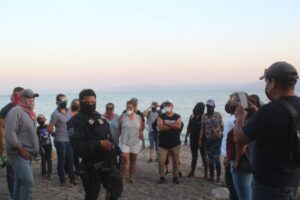
La policía se hizo presente en un momento de la reunión; los asistentes dijeron sentirse agredidos por el actuar de los elementos. Foto: Sofía Medeles.
Al terminar de retirar las invasiones federales, los congregados hablaron de otros puntos de Ajijic que registran la misma situación, acordando monitorear y recuperar los lugares que ya habían sido liberados al poniente de la delegación, así como ayudar a las personas de otras poblaciones para replicar el movimiento “anti-rejas”.
“Se extrañan los tiempos donde se podía caminar desde Chapala hasta Jocotepec por la orilla del lago. Esos tiempos volverán, si todos nos unimos por esta causa, para que nuestra descendencia disfrute de las playas libres, que son derecho de todos”, afirmó un miembro de Pueblos Unidos de la Ribera.
El pasado primero de abril los activistas se volvieron a reunir para apoyar a los habitantes de la delegación de San Antonio Tlayacapan, para después continuar en el Pueblo Mágico.
Pueblos Unidos de la Ribera es un movimiento que se conformó en los primeros días de agosto del 2021, tras tres reuniones en las que se derribaron todo tipo de cercados en las playas del oriente, entre la zona de Tío Domingo y Villa Lucerna, decidieron manifestarse en las oficinas de la CONAGUA en Guadalajara.
Aunque la dependencia “dio su brazo a torcer” y les prometió estar más al pendiente de las invasiones al desplegar más inspectores, además de que se les indicó que no estaban incurriendo en un delito al quitar las obstrucciones, a la fecha, la CONAGUA ha hecho caso omiso de los acuerdos.
Paving stones to be replaced with concrete along Francisco I. Madero Avenue
The project proposes removing paving stone and replacing with concrete on Francisco I. Madero Avenue. Photo: Jazmín Stengel.
Jazmín Stengel (Chapala).- Chapala President Alejandro de Jesús Aguirre Curiel announced that the paving stones along Francisco I. Madero Avenue will be replaced with concrete by the Government of Jalisco in coordination with the Secretary of Infrastructure and Public Works of the State (SIOP).
The 80 million peso project includes the replacement of the paving stone with cement, the restoration of sidewalks and curbs (machuelos), as well as a subsidy to the merchants to upgrade their image along the Avene.
Laguna surveyed local citizens about their response to the project. Of twenty-two people interviewed in a survey in neighborhoods in the western part of the municipality, half said they were unaware of the plans to remodel Chapala’s main avenue, Francisco I. Madero.
While eight of the people informed about the issue were against it, three others approved of the project.
«As long as they do something, they can do it however they want» or «it would be fine,» were the most heard answers during the tour that Semanario Laguna made along the street.
Two of merchants who heard about it disagreed because concrete absorbs heat, is impermeable and its deterioration is more noticeable.
«The paving stone absorbs water, while concrete does not. The paving stone can be repaired in sections,» argued the owner of a veterinarian’s shop on the avenue, who also has a background in engineering.
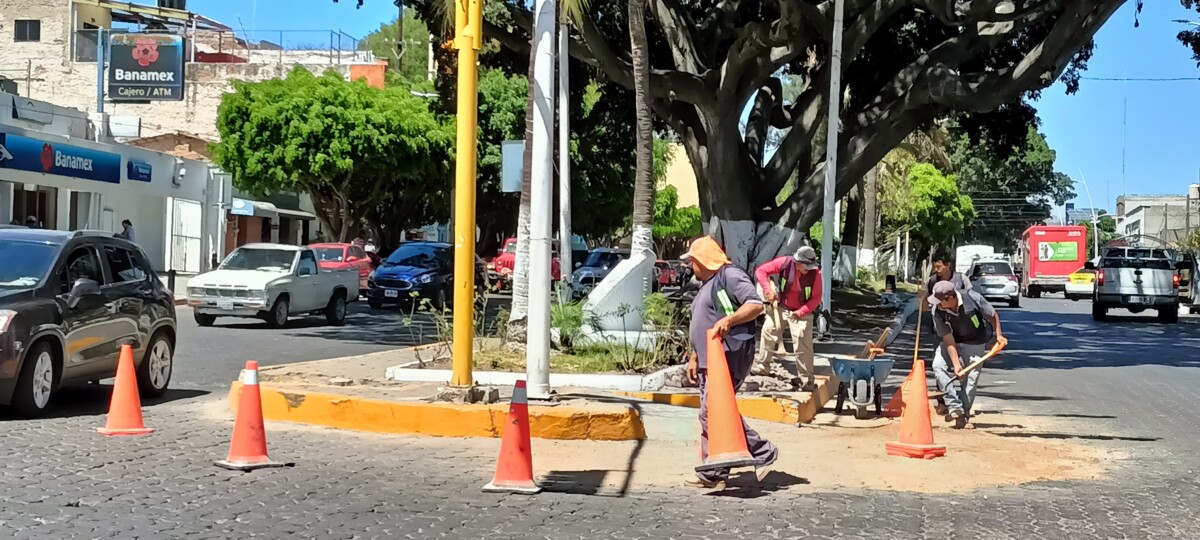
City workers repairing Francisco I. Madero Avenue. Photo: Jazmín Stengel.
A young pharmacist and environmentalist said that these types of materials «affect climate change.”
Others felt that it is an «unnecessary investment» because the paving stone can be lifted in parts, which makes it easier to repair, while the concrete is compacted in one piece, making the deterioration more visible and more expensive to restore, explained a woman interviewed in front of Chapala’s main square.
The project «looks nice, but the joke is that it lasts,» said a vendor near the central plaza. Her neighbor saw the need to give priority to the street repair around downtown, which «looks like you’re riding a donkey” when you drive down the road.
The poor drainage conditions and the slipperiness of the sidewalk tiles also caused a lot of talk. During the rainy season the drains overflow into the commercial businesses in the area.
The sidewalk tiles become slippery when wet, which has already caused several pedestrian accidents, according to neighbors.
«They only fix the showy stuff,» argued Carmen’s husband, accustomed to the fact that public consultations on projects of this type are non-existent in the municipality. To which his wife added: «Hold on! The government always gets its way.»
Translated by Nita Rudy
Lack of working streetlights leaves Chapala inhabitants feeling insecure
One of the private neighborhoods on Pino Suaréz street in the municipal capital. While it is illuminated, it is not enough, according to the neighbors. Photo: Jazmín Stengel
Jazmín Stengel (Chapala).- Although the municipal capital of Chapala has enough streetlights, the inhabitants feel insecure because many of them aren’t working or aren’t well placed, as evidenced by a tour of the San Miguel, Puerta del Horno and Plaza de Toros neighborhoods.
During the tour we interviewed more than 10 pedestrians and neighbors of the area, who said they felt unsafe despite the functioning street lights, explaining that «the lamps do not illuminate where it is most needed.”

The beginning of Privado Aguascalientes with all its lights on. Photo: Jazmín Stengel
On Privada Aguas Calientes and Prolongación Pino Suaréz, two street lights were repaired more than a year ago and have not broken down again, commented one of the neighbors, who pointed out that a well-lit street is safer for both pedestrians and residents.
A little further on, on the third bridge of Pino Suarez Street, the street lights were repaired a few months ago but have not been maintained.

Guayabos Street, one of the darkest streets in the municipality. The neighbors say they have never had electricity here. Photo: Jazmín Stengel
The residents of Guayabos Street, from the intersection with Pino Suarez and Plutarco Elias Calles, stated that they have never had any lighting.
In view of this problem, the coordinator of Municipal Public Services, Jose Antonio Urzua Gracían, stated that he is working full time to solve the lack of lighting in the municipality, despite being left with serious deficits in vehicles and tools since the change of administration.
An analysis made by Antonio Urzua pointed out that in the municipality there are about 6,000 streetlamps, but only 15 to 20 percent were functional when the administration started. «We received a dark municipality, with a great number of complaints,” he said. Six months later they have managed to solve 60 to 70 percent of the problems in the towns of the Chapala municipality.

Jóse Antonio Urzua Gracían, coordinator of Municipal Public Services in the municipality of Chapala, during the interview with Laguna. Photo: Jazmín Stengel
So far, 600 new streetlights have been purchased and 400 more have been repaired by recycling the most useful parts to others, so that only $1,200,000 pesos (about US$60,000) have been spent on repairs, in addition to 400,000 pesos (about US$20,000) on replacing wiring, which is often stolen.
The recycling strategy is useful for saving money, and also to adapt to the lamps already in place. Not all of them are the newer LED technology, and many break down and cannot be repaired due to lack of compatibility with the available parts, or because their life span has been exhausted.
Translated by Sandy Britton
Cyclist hit by vehicle in Ajijic
The mishap happened at the entrance to a gas station
Editor: A cyclist was left lying on the pavement of the Chapala-Jocotepec highway, after being hit by a pickup truck.
The victim was riding on the bicycle path in the La Canacinta area during the afternoon of March 23, when he was surprised by a truck accessing the entrance to the gas station. Apparently, the driver of a beige Jeep-type truck did not notice the cyclist.
The victim was attended by Red Cross personnel, prior to being evaluated by Chapala Fire Department personnel, while a traffic police officer investigated the accident.
Translated by Nita Rudy
Chapala president calls upon citizens to unite on 216th anniversary Benito Juárez’s Birthday
The president of Chapala, Alejandro de Jesús Aguirre Curiel, and local deputy, María Dolores López Jara offered a floral arrangement at the “Benemérito de las Américas” Credit: Jazmín Stengel
Editor (Chapala).– Chapala President Alejandro de Jesús Aguirre Curie called for citizens to unify in the municipality and leave divisions behind during the commemoration of the 216th anniversary of Benito Juárez’s birthday
«May the framework of this celebration for the 216th anniversary of the birth of Benito Juarez, be the perfect reason to overcome harsh divisions, and unite in favor of Chapala and Chapala residents.» Aguirre told the citizens, adding that, «The example of Benito Juarez should remind us of the principles of democracy, equality, tolerance, and respect – indispensable foundations of the rule of law of any nation.» At the event, students from the Eugenio Zúñiga elementary school provided a short history of the life of Benito Juarez, also known as “Benemérito de las Américas” or “deserving of the Americas’ praise.” Valentín Gómez Farías highlighted Juarez’s history of public service including: the governorship of Oaxaca, magistrate of the Supreme Court of the Nation. As president of Mexico, he is credited with major legal reforms.
Translated by Amy Esperanto
13th Bikini Car Fest celebrated without pandemic controls
Bikini models from various nightclubs stole the attention of attendees. Photo: Jazmín Stengel.
Jazmín Stengel (Chapala).- The 13th Bikini Car Fest was held Sunday, March 20, as it was done “before the pandemic.” Masks and antibacterial gel were generally not required, but there were cars, drinks and women.
The event started at 7am in Chapala’s Parque de la Cristianía. The only “sanitary filter” was at the main entrance where pedestrians were checked. Control was not very strict, since many entered without masks. At the access for cars, through the parking lot, there were no controls.

This year’s Bikini Car Fest awarded 70 categories. Photo: Jazmín Stengel.
After being canceled for two years due to the pandemic, the event showcased around 900 modified and exhibited cars. About 450 were entered in one of the multiple categories of the Bikini Car Fest. A total of 280 prizes were awarded to 60 percent of this year’s participants, according to organizers.
The number of categories may vary according to the cars entered, since it takes at least five cars with the same characteristics to open a new category. If there are not sufficient entries, cars can be entered in other categories compatible with their modifications. These can vary between the trends of tuned or modified cars such as the euro and DJM branches, open and air-cooled, among many other subcategories. In the end, 70 categories were awarded, all with first, second and third places.

As well as the categories, the models of classic and modified cars were very varied. Photo: Jazmín Stengel.
The audio sound specialists were divided into two main ones, SPL and Open Show, which in turn were divided into 10 other subcategories according to the type of amplifier. In the audio category, 50 cars participated, of which up to 30 of them were awarded the first three places in each subcategory.
There were also 20 prizes for the best modified car on display, as well as 50 more prizes for the special car of the event, or what is equal to the second place of the best cars, organizers said.
In addition to the cars, articles and spare parts for sale, bikini models from the Cadillac, Roma and Chicas de Guadalajara nightclubs, as well as the Models Brasil models from different Latin American countries, stole the public’s attention.
Translated by Mike Rogers
Anuncia Gobernador de Jalisco inversión de 213 millones de pesos para cuatro obras en Chapala
El Gobernador de Jalisco, Enrique Alfaro Ramírez, junto al presidente de Chapala, Alejandro de Jesús Aguirre Curiel, durante la entrega de los 16 kilómetros de ciclovía pertenecientes al municipio de Chapala, frente al parque La Milagrosa, en la entrada a la cabecera municipal. Foto: Jazmín Stengel.
Jazmín Stengel.- El Gobernador del estado, Enrique Alfaro Ramírez, anunció una inversión superior a los 213 millones de pesos para cuatro obras, en el municipio de Chapala.
Durante su gira por la Ribera de Chapala, realizada el pasado 25 de marzo, el gobernador entregó la ciclovía Chapala-Jocotepec, anunció la rehabilitación de la avenida Francisco I. Madero de la cabecera municipal y supervisó las obras del Auditorio de la Ribera, la Telesecundaria Guadalupe Victoria y El Instituto Tecnológico Superior Mario Molina; además de tres futuros proyectos en otras escuelas del municipio.
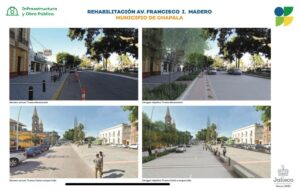
Así se prospecta la rehabilitación de la entrada a Chapala, avenida Francisco I. Madero; el costo total será de 97.5 millones de pesos aproximadamente. Foto: Jazmín Stengel.
Alfaro Ramírez entregó los 16 kilómetros de ciclovía construidos en Chapala. La obra que comenzó en el 2019 se realizó en dos etapas y una obra complementaria que, en conjunto, tuvieron un costo de 87 millones de pesos, como parte del programa estatal Mi Bici.
La ciclopista que inicia en la cabecera municipal y termina en Jocotepec, cuya extensión es de 24.3 kilómetros, tuvo un costo total de 211 millones de pesos, informó Enrique Alfaro.
La rehabilitación del ingreso principal a Chapala, avenida Francisco I. Madero, también fue presentado por el gobernador durante su gira, mediante la grabación de un video. Esta obra de 900 metros lineales será dividida en dos etapas para evitar afectar el tránsito de la zona.
Para la primera ya se gestionaron 17.5 millones de pesos y los trabajos iniciarán después de las vacaciones de Semana Santa y Pascua, aunque no se dio a conocer un presupuesto para el total de la obra, el alcalde de Chapala, Alejandro de Jesús Aguirre Curiel, estimó un gasto aproximado de 80 millones de pesos para la segunda etapa.
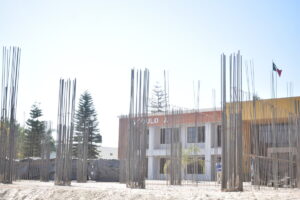
El módulo en construcción en el Tecnológico ‘Mario Molina’ de Chapala tendrá un gasto de 40 millones de pesos. Foto: Jazmín Stengel.
La obra tiene tres objetivos principales: La primera será mejorar la vialidad, cambiando el actual adoquín por cemento hidráulico y renovar las redes hidrosanitarias que pasan debajo de la misma; el segundo objetivo es ordenar el estacionamiento de manera paralela para que los automóviles «ya no echen en reversa» a lo largo la avenida, así evitar percances en el tránsito y mantener dos carriles moderados.
Por último, se planea un cambio de imagen urbana que consiste en instalar una fuente al andador, casi frente a la parroquia de San Francisco de Asís, extender la ciclovía hasta el malecón y así convertirla en una «calle compartida», además de modernizar el mobiliario urbano y atender el arbolado.
Para este objetivo, un porcentaje del presupuesto aún no confirmado se entregará a los comerciantes de la avenida con el fin de que también mejoren su imagen uniformando la misma. Esta labor se le delegó al Ayuntamiento de Chapala para comenzar la organización y gestión social. Las construcciones mencionadas están a cargo de la Secretaría de Infraestructura y Obra Pública del Estado (SIOP).
En el recorrido, también fueron supervisadas las obras del Auditorio de la Ribera que, entre sus tres etapas se estima un gasto de 70 millones de pesos, además de las escuelas Telesecundaria ‘Guadalupe Victoria’, en la delegación de Santa Cruz de la Soledad y el Instituto Tecnológico Superior Mario Molina de Chapala. A este último se le otorgaron 40 millones para construir un nuevo módulo de aulas.
El edificio contará con 18 aulas nuevas, completamente equipadas, salones de usos múltiples y una biblioteca. Además, el gobernador Enrique Alfaro prometió tener lista la Red Jalisco de internet de alta velocidad en las próximas tres semanas. Esta red también se implementará en la telesecundaria Guadalupe Victoria.
Durante su visita a la Telesecundaria en Santa Cruz de la Soledad, el mandatario estatal dijo haber invertido 12.9 millones de pesos en la nueva infraestructura y prometió a los presentes poder estrenar las instalaciones, con nuevos módulos de aulas, computadoras Google e internet de banda ancha, en los próximos diez días. Con las instalaciones en uso, los trabajos continuarán con la habilitación de baños, áreas deportivas y de convivencia.
Alfaro aprovechó la ocasión para mencionar que el ajuste gradual de impuestos sobre la nómina que las diputadas María Dolores López Jara y Claudia Murguía Torres lograron gestionar, se recaudó este año cerca de 880 millones de pesos que formaron el primer fideicomiso para arreglar las escuelas del estado. Se espera que el próximo año, la recaudación aumente a dos mil 500 millones de pesos.
Con este fideicomiso se logró trabajar en 700 escuelas de los 125 municipios de Jalisco hasta ahora, se necesitan «36 mil millones de pesos para arreglar todas las escuelas del estado», aseguró Enrique Alfaro. Las Secundaria Foránea No. 1, José Vasconcelos y la Primaria Eugenio Zúñiga de Chapala, así como el Centro de Atención Múltiple (CAM) de Atotonilquillo están etiquetados para ser intervenidos el próximo año.
Enrique Alfaro también se comprometió a terminar el último tramo de carretera que une a Santa Cruz de la Soledad con Ixtlahuacán de los Membrillos, se escucha en uno de los videos publicados en las redes sociales del mandatario durante su gira.
Festejan con actividades culturales el natalicio del escritor Octavio Paz
El CUOP celebró el natalicio de Octavio Paz con reseñas de vida y lectura de poemas del escritor que le dio nombre a la institución educativa.
Redacción. Con actividades deportivas y culturales los alumnos del Campus Universitario Octavio Paz (CUOP), conmemoraron el 108 natalicio del poeta y escritor mexicano que ha dado el nombre al campus ubicado en Ajijic.
El acontecimiento llevado a cabo el 31 de marzo inició con los honores al lábaro patrio bajo la custodia de la escolta de primaria, luego se narró parte de la vida del poeta por alumnos de secundaria, al tiempo que se dio vida al escritor representado por alumnos de primaria.
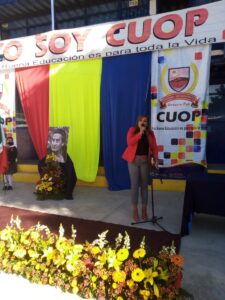
Elizabeth Gutiérrez, Rectora del CUOP, agradeció y felicitó a todos los participantes en el evento.
Además, los más pequeños del CUOP, alumnos de maternal y preescolar, realizaron una suelta de globos simbolizando la eternidad de su obra.
El nivel medio superior participó con la interpretación del poema «Otoño», el cual se presentó en idioma español e inglés.
Los jóvenes pertenecientes al plan de estudios de la Universidad de Guadalajara (UdeG), leyeron en voz alta el cuento «El Ramo Azul», que concluyó con un recorrido de frases de la obra del poeta. De manera continua, se prosiguió con la entrega de reconocimientos a alumnos que participaron en el torneo matemático de LIMATEJ, organizado por la Secretaría de Educación Jalisco (SEJ), así como a los estudiantes que obtuvieron el primero y segundo lugar.

Los más pequeños del CUOP, alumnos de maternal y preescolar, realizaron una suelta de globos.
También se premió al equipo de docentes que ganó el torneo relámpago de voleibol días atrás, al igual se entregaron uniformes a la selección varonil y femenil del voleibol de secundaria; los alumnos de bachillerato obtuvieron el tercer lugar de esta misma disciplina a nivel municipal.
Para finalizar el evento, la maestra Elizabeth Gutiérrez, Rectora del Campus Universitario Octavio Paz, agradeció y felicitó a todos los participantes en el evento, invitándolos a seguir preparándose y cosechando buenos resultados tanto en lo académico como deportivo.
© 2016. Todos los derechos reservados. Semanario de la Ribera de Chapala
